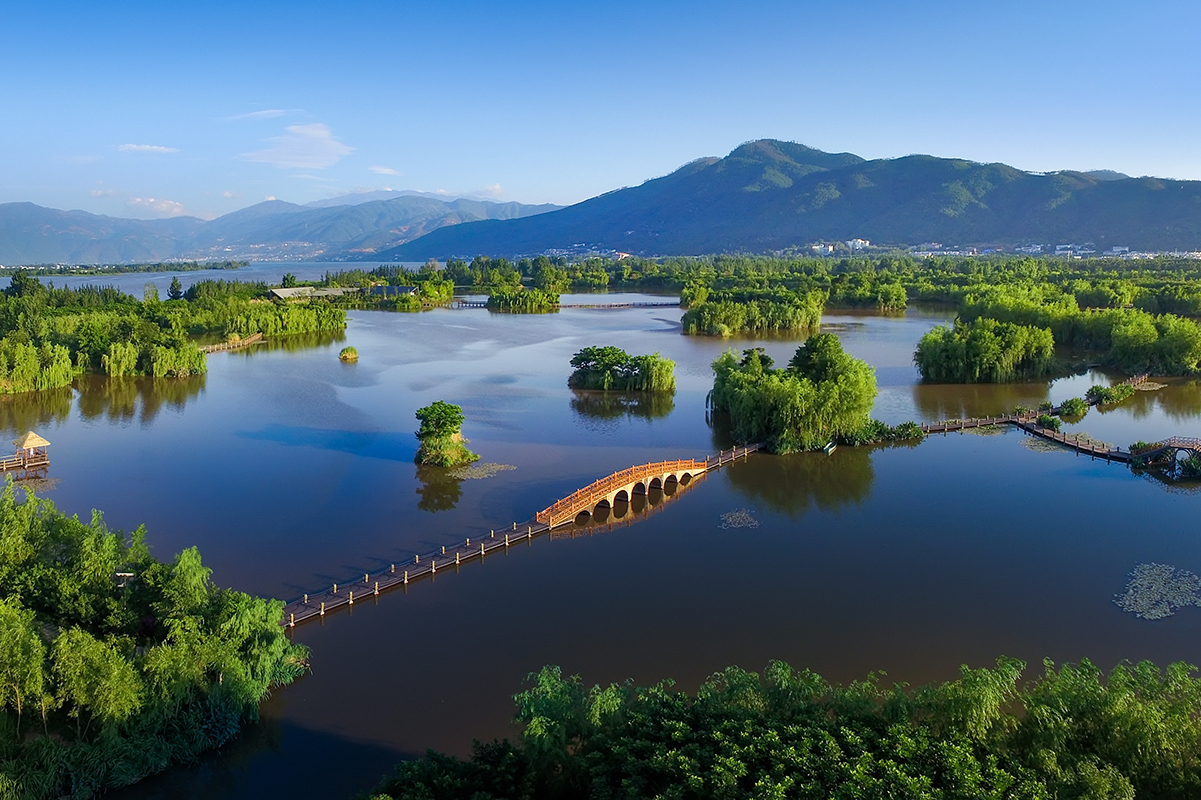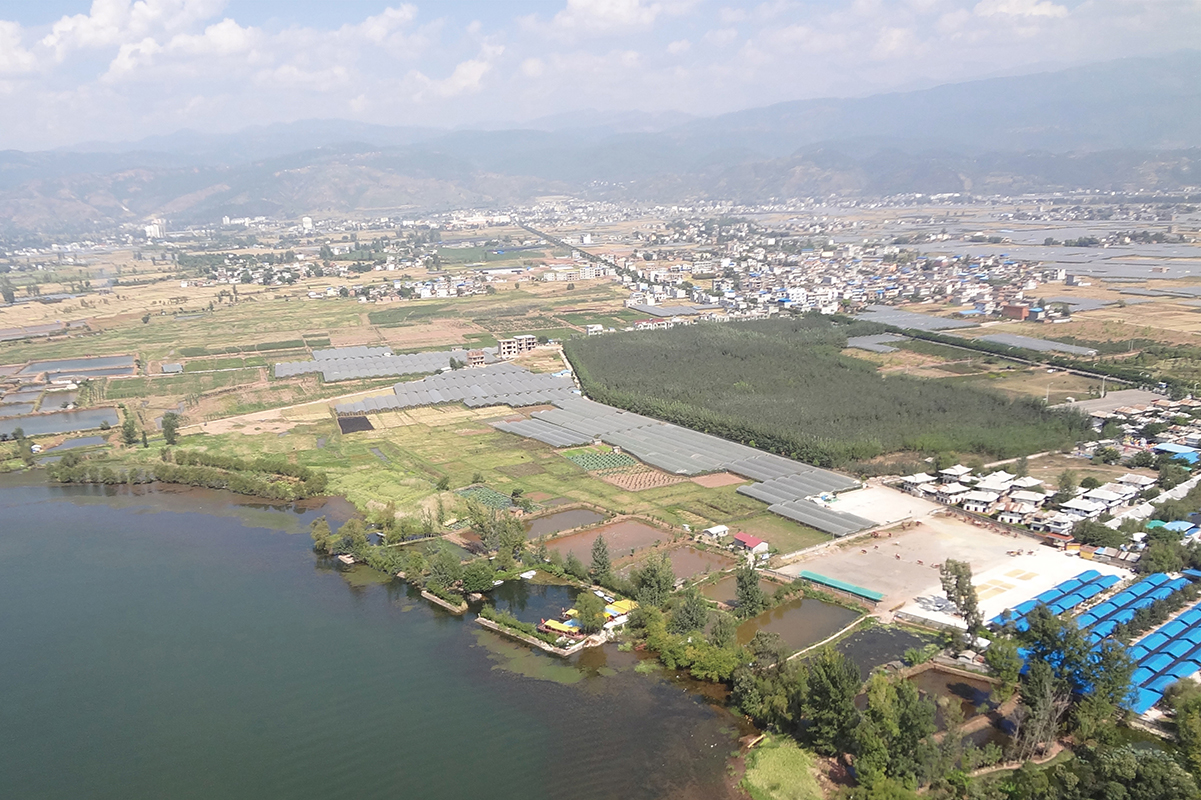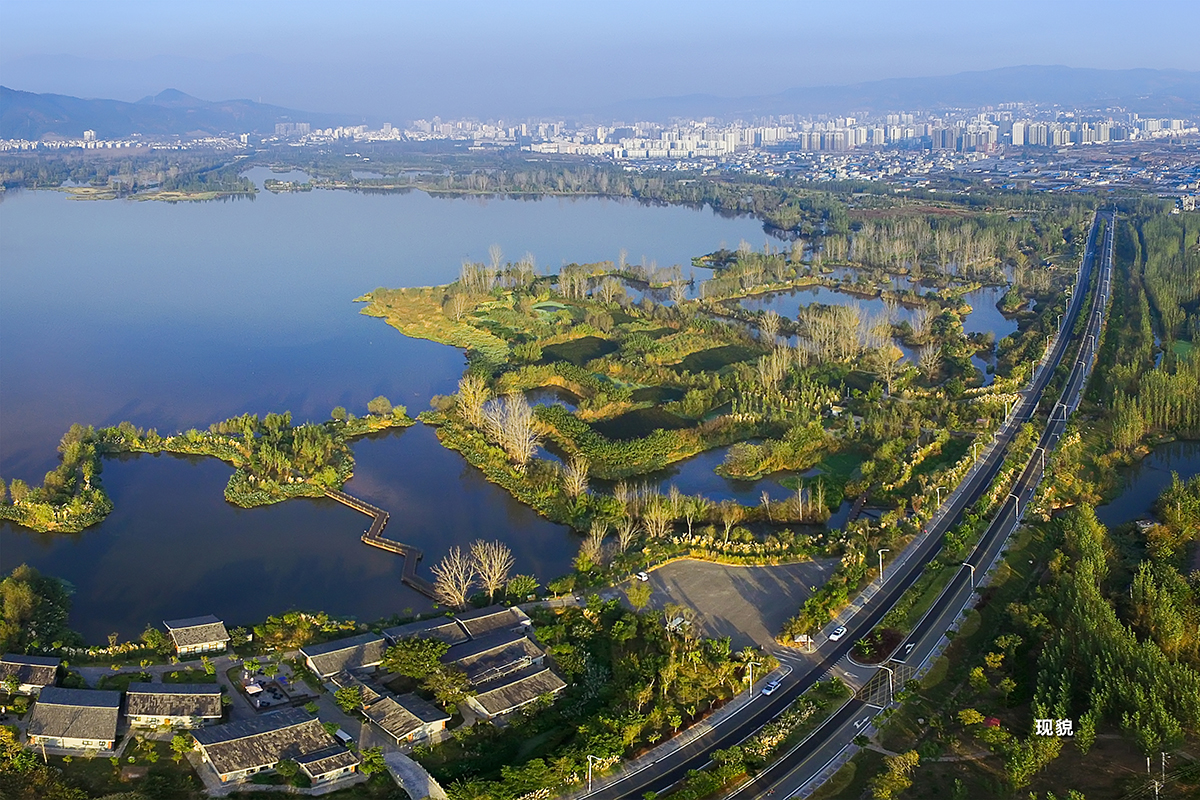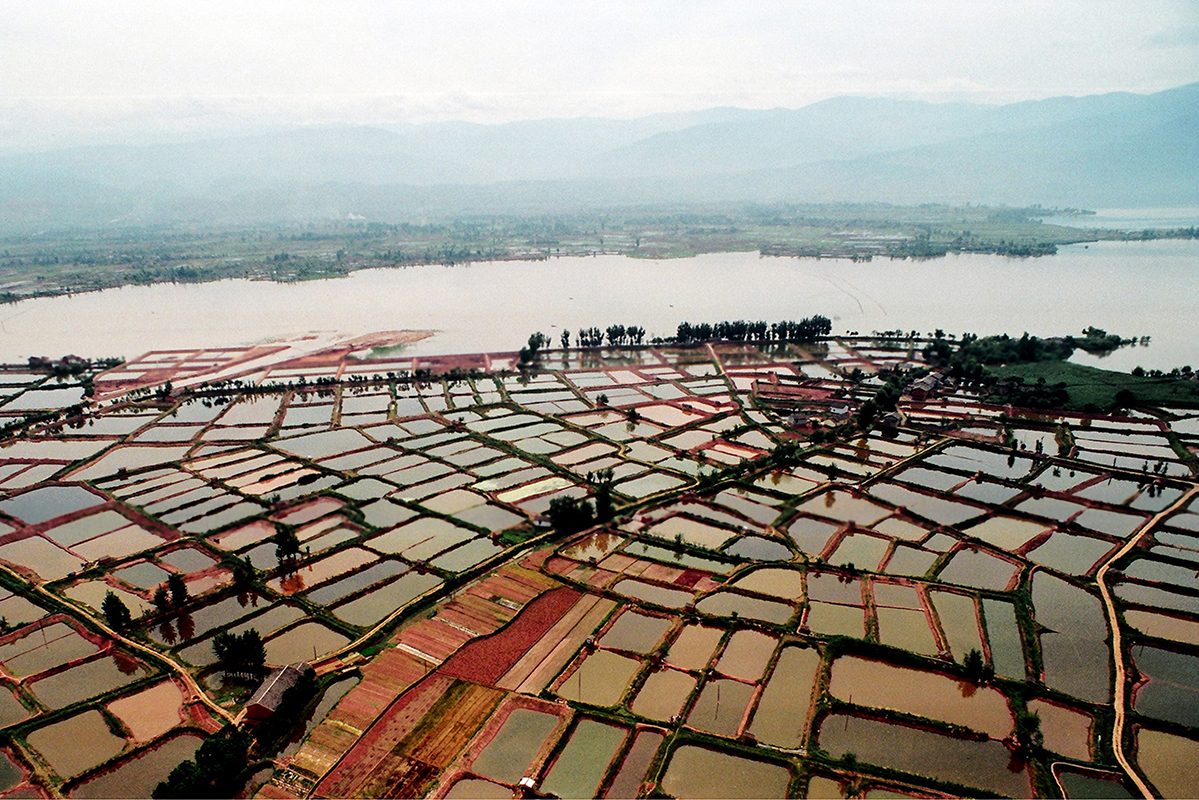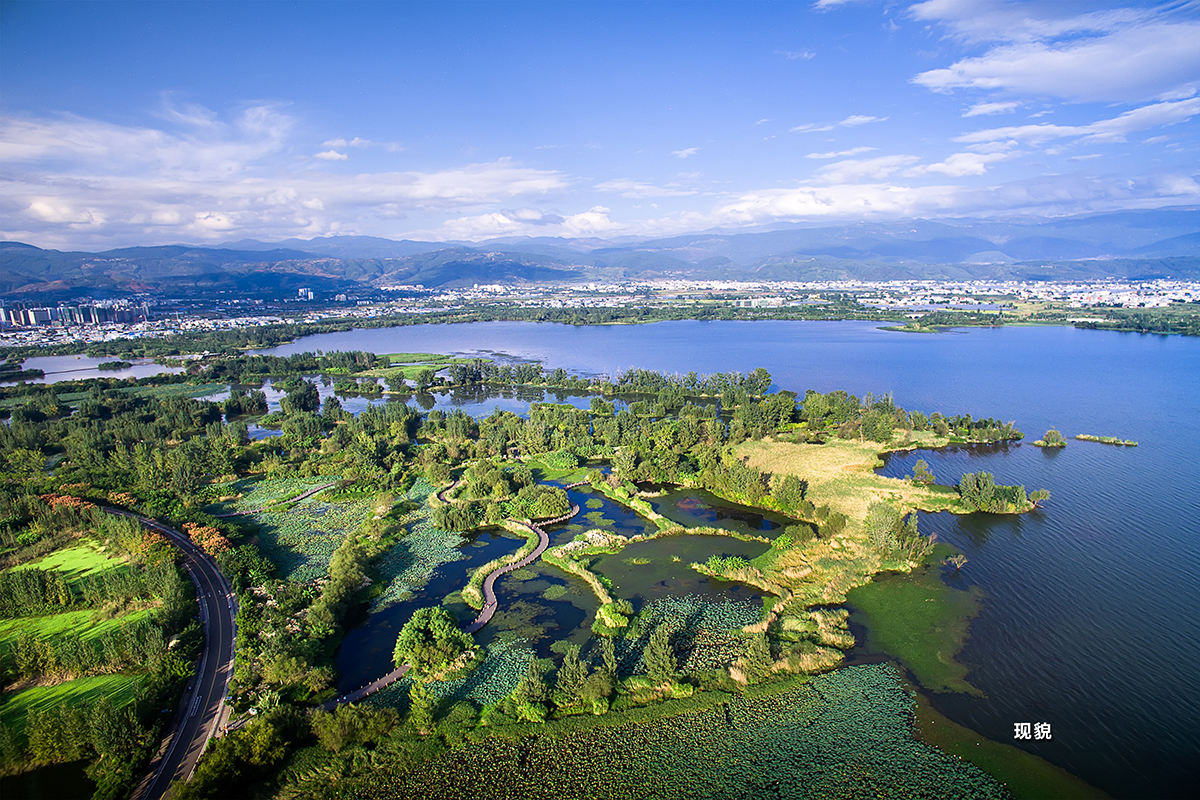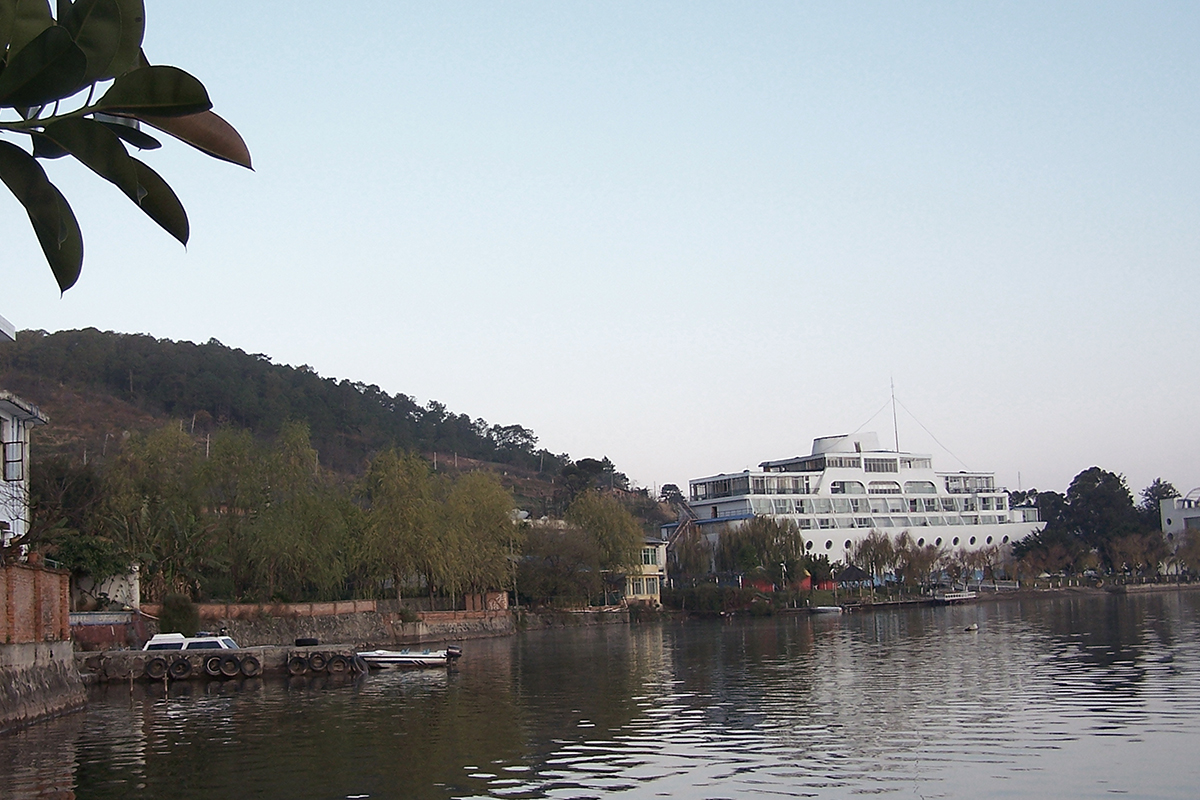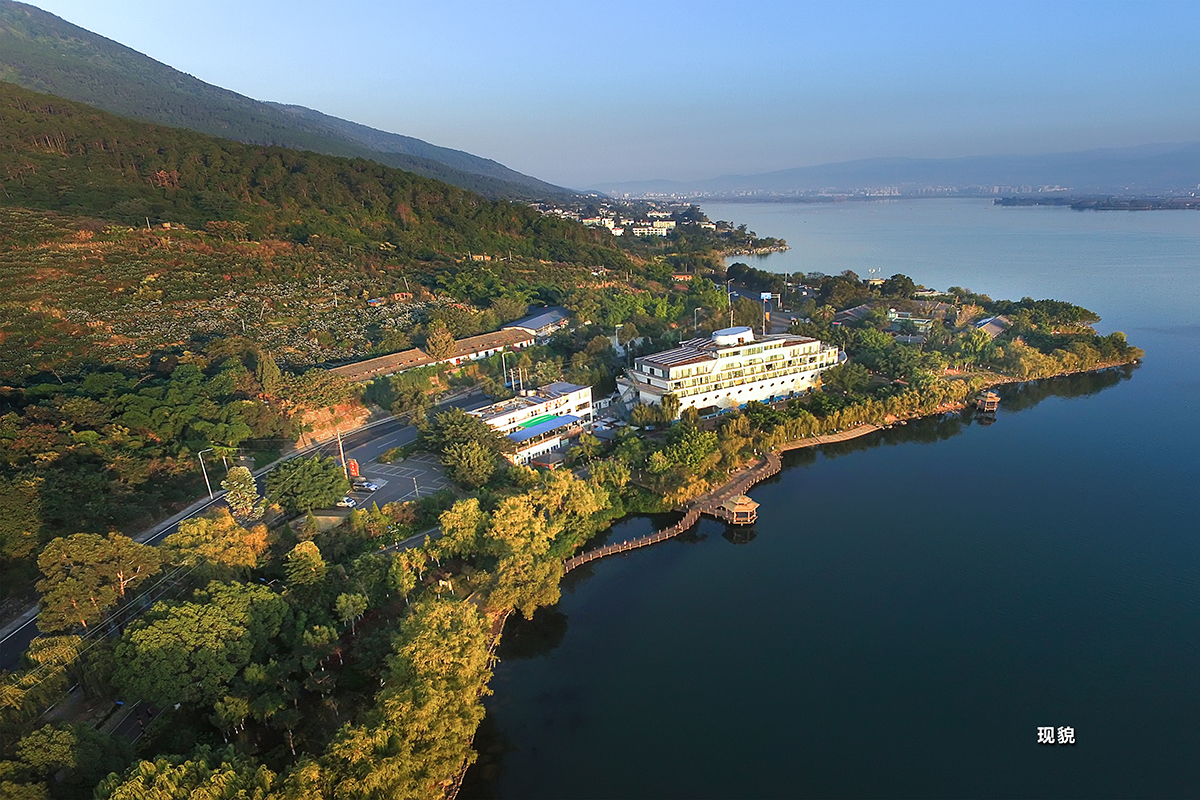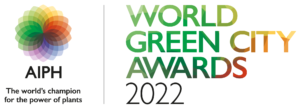Addressing the urban challenge
Breadth of the issue – How are the problem(s) that are being tackled by your initiative affecting citizens/local businesses or a significant component of the local wildlife?
Through the ecological protection and restoration of Qionghai wetland project, especially by way of afforestation, water and soil can be conserved, and water and soil loss can be reduced. At the same time, it can effectively improve air quality, regulate regional climate, and maintain ecological balance.
The implementation of wetland such as lakeside belt restoration can not only protect biodiversity and purify water quality, but also regulate microclimate, provide tourism resources, and play a great role in carbon sequestration and emission reduction and coping with climate change.
Depth of the issue – How seriously are the problems being tackled by your initiative impacting the life of the citizens/businesses/wildlife concerned?
In 2017, the vegetation coverage rate of Qionghai basin reached 53.7%, and the area of Qionghai water area and wetland recovered to thirty-four square kilometres. Qionghai now operates within the safe water level according to the natural rhythm as a result of the project.
The water quality compliance rate of Qionghai centralized drinking water source is 100%, and the regional air quality and noise monitoring meet the national first-class standards. 35km lakeside zone has been repaired, as a result, the forest and grass coverage around the lake has reached 92%, and the biodiversity has been restored. There are 498 kinds of vascular plants, forty-two kinds of fish, 210 kinds of birds, of which 27 kinds are under national first and second-class key protection.
The project also provides citizens with an ecologically beautiful, green, and low-carbon place for leisure, fitness and entertainment, solves the employment of the relocated people and helps create characteristic industries, realizing the win-win development of ecological protection and Rural Revitalization.
The power of plants and natural ecosystems to deliver benefits
How is the initiative shaped by scientific evidence of the potential for plants and natural ecosystems to deliver benefits?
The city took the lead in issuing the first local regulation, the Regulations on the Protection of Qionghai Lake in Liangshan Prefecture, which provides a strong legal guarantee for the governance of the lake and the protection of the ecological environment of Qionghai River Basin in ethnic minority areas in China.
The city also makes dozens of plans such as Qionghai Basin Environmental Plan with high standards, aiming to scientifically lead the protection, construction and management of Qionghai wetland. Through the adjustment of administrative division, Pushi Township, mazeng Yiwu Township and Donghe township of Xide County in the river basin are classified into Xichang City for unified management, so as to realize the unified planning and management of the whole river basin.
How has the city exploited the potential of plants and associated ecosystems to deliver more than one benefit?
The party committees and governments at the three levels of Sichuan Province, Liangshan Prefecture and Xichang City have systematically planned to establish the historical positioning and long-term goal of building Xichang City into an “international, ecological, pastoral, historical and cultural city”. They set up the governance concept of “repairing a wetland, revitalizing a lake and benefiting the residents of the city”. All the administration departments involved work cooperatively to implement measures such as legislative guarantee, planning guidance, ecological relocation, and comprehensive watershed management, so that urban development and ecological protection of Qionghai can coexist in harmony.
Innovative and Collaborative Solution
In what ways is the initiative innovative?
With the disorderly development of farmhouses, stilts, private cruise ships and cage fish farming around Qionghai, nearly two-thirds of the lakeside wetlands have been seriously damaged, the beach and native wetland vegetation have basically disappeared, alien species have invaded, waterfowls and native species have decreased. Consequently, the ecological function of Qionghai wetland is decreasing day by day, and the water area of Qionghai has been reduced to less than 27 square kilometres, The water quality is reduced from class II to class III and below, and the safety of drinking water is seriously threatened.
How is the initiative supported by collaborative working across disciplines and sectors?
In order to understand the impact of the project implementation on the water quality of Qionghai lake, the local government made a detailed plan for the water quality monitoring of Qionghai lake. Mandatory provisions are made on the monitoring points, monitoring factors, frequency, quality assurance and quality control of Qionghai water quality monitoring in Xichang to ensure that the effect of the project implementation can be truly and intuitively reflected.
How does the initiative demonstrate evidence of community support?
Xichang City has established the historical positioning and long-term goal of “international, ecological, pastoral, historical and cultural city”. To achieve the foal, the city employs a series of measures. First, make scientific planning and manage the lake according to law. Dozens of plans such as Qionghai Basin Environmental Planning and Qionghai National Wetland Park Master Plan have been made with high standards, forming a scientific and complete planning system for protection, construction and utilization of the lake area. The second is to adopt the mandatory protection measures of “only going out but not going in, only demolition but not construction”, build more than 13km2 of wetland around Qionghai Lake in six phases, and restore 1,067 hectares of Lake Wetland and lakeside belt. Third, the government has implemented the ecological restoration and management project of Qionghai basin. Various afforestation projects such as artificial afforestation, returning farmland to forests and ecological restoration around Qionghai have been implemented in the natural conservation project. By the end of November 2021, a total of 79km2 of artificial afforestation had been implemented. Fourth, in 2020, the city implemented the water and soil conservation project in the lower reaches of the e’zhang River, controlled the water and soil loss area of 12.09 km2, and built a sand retaining dam with a storage capacity of 31,000 m3.
Implementation, Impact and Replicability
How does the initiative demonstrate evidence of a track record of success against pursued objectives?
The total investment of Qionghai wetland protection and restoration project is nearly 5 billion yuan. The money comes from: first, 468.92 million yuan of national and provincial investment; Second, the local government has raised funds for the protection and restoration of Qionghai wetland and has invested more than 4 billion yuan. During the project, China’s first-class technical units represented by China Urban Planning and Design Institute have been hired as the technical adviser. The government of the city organized more than 30 administrative departments represented by Xichang Qionghai Lushan Scenic Spot Administration to participate in the work and share the responsibilities of project promotion, supervision, and cooperation.
How has the initiative had a ripple effect beyond the scope of the initiative itself, thereby demonstrating a change in the city’s and/or its partners’ way of working with plants?
The project guides the relocated people through policy support, vigorously develops high-quality home stay, characteristic catering, and other industries, and opens up the way to increase income of local people. Many measures have been supported by the relocated people. We have achieved our goal with cooperation and assistance of the following institute: China Institute of Urban Planning and Design; Shanghai Tongji Institute of Planning and Design; School of Environment, Peking University; Yunnan Institute of Environmental Sciences; Chinese Academy of Environmental Sciences; National Plateau Wetland Research Centre; Kunming survey and Design Institute of the State Forestry administration; Chengdu Institute of biology; Chinese Academy of Sciences; Sichuan Academy of Environmental Sciences Sichuan Academy of forestry; Sichuan Bureau of Surveying and Mapping Geographic Information; Southwest Forestry University; Xichang University;, Leshan Normal University and other domestic first-class technical units and relevant professionals.
How have other cities expressed interest in the initiative, or what potential does it have to interest other cities and be customised to their own circumstances?
Through systematic restoration and protection, the 35km lakeside zone of Qionghai has been restored, the forest and grass coverage around the lake has reached 92%, and the ecological environment function of the lakeside zone has been restored. A good habitat for the survival and reproduction of waterfowl, fish, insects, and microorganisms has been created. In recent years, there are 498 species of vascular plants and 210 species of birds in the wetland, of which 15 species was added in 2021. The water quality of Qionghai Lake is stable, reaching class II, and the comprehensive nutritional state index of the lake is 35.2, belonging to the mesotrophic level.
Sustainability and Resilience
What efforts have been made to reduce the carbon footprint of the initiative?
With the implementation of the project, many aspects of Xichang City, such as people’s livelihood, economy, and society, have been actively improved. First the livelihood: With the implementation of Xichang wetland protection and restoration project, the construction has solved the housing problem for over 9,000 villagers and more than 30,000 people in six townships around Qionghai. Second, in terms of economy, the implementation of Xichang wetland protection and restoration project has promoted the development of Xichang tourism. In 2020, although affected by the epidemic, but Xichang received 9.8757 million tourists and realized a tourism revenue of 3.353 billion yuan; From January to November 2021, it received 10.2643 million tourists, realizing a comprehensive tourism income of 3.631 billion yuan. The economic model of Xichang has changed from a single city dominated by the primary and secondary industries to a good economic development in which the three industries go hand in hand, the economic mode is diversified, and the economic model is developed at multiple points. About social aspect, Xichang wetland scenic spot echoes with the tourist spots in the old urban area, providing citizens with construction of infrastructure and service facilities of a leisure, fitness and entertainment place with good ecology, safe and orderly leisure, guiding people’s life to go green and healthy, and attracting large-scale activities such as Chinese Spring Festival Gala and World Marathon into Xichang, so that Xichang is not just a small city in the southwest of China, but gets the opportunity to show its style internationally.
How have the anticipated impacts of climate change been considered?
After the implementation of the project, the ecological environment of Qionghai has been greatly restored, and Qionghai has successively won dazzling honours such as “National Wetland Park”, “National Ecological Civilization Education Base”, “National Environmental Protection Science Popularization Base”, “National Tourism Resort”, “National Wetland Tourism Demonstration Base”, “National Science Popularization Education Base” and “National Forestry Science Popularization Base”.
In May 2018, the special documentary “Approaching the Wetland and Embracing Nature” Filmed in Qionghai wetland by CCTV and Hong Kong Satellite TV’s “Beautiful China Tour” column team also made a positive publicity report on the achievements of the protection and restoration of Qionghai wetland. Qionghai, the “Pearl of the Plateau”, will enter the international stage through the promotion of CCTV, Hong Kong Phoenix Satellite TV, and Hong Kong Satellite TV. Many cities also admire and come to conduct on-the-spot investigation and study.
What processes does the initiative include for it to be considerate in its use of soils and other natural resources?
First, 1,333 hectares of lakeside wetlands have been built around Qionghai, and 1,067 hectares of lakeside wetlands and lakeside belts have been restored. According to statistics, the carbon sequestration rate of lakes and wetlands is 5-72g / (M2·a). Taking 38g / (M2·a) for calculation, the carbon sequestration capacity is about 912mg / a. Second, the project implements the natural forest resources protection project to effectively protect the forests around Qionghai. Since 1998, an area of 4133 hectares has been closed off for afforestation; By November 2021, 7,877 hectares of artificial afforestation had been implemented. According to the evaluation results of forest ecosystem service function and its value, pine species sequester 0.21 tons of carbon per mu per year, and the carbon sequestration capacity is about 37833.6Mg/a.
Monitoring, Maintenance, and Management
How has the initiative been designed and implemented so that long-term needs for management and maintenance are reduced and can be met?
The average temperature in Xichang is 17.2 ℃, the highest in August is 23.8 ℃, the lowest in January is 9.4 ℃, and the annual temperature difference is 13.0 ℃. It is one of the regions with the smallest temperature change in China, and the climate is very pleasant. Qionghai Lake, located about 5km to the southeast of Xichang City, is a freshwater lake of plateau structure and the second largest freshwater lake in Sichuan Province. Due to the low reflectivity of Qionghai to solar radiation, large specific heat capacity of water body and high evaporation heat consumption, the temperature change on the lake is mild compared with the surrounding land, warm in winter, cool in summer, warm at night and cool in the daytime. Therefore, Qionghai plays a great role in regulating the climate around Xichang. By improving the water environment of Qionghai, the regulating effect of Qionghai on the climate of Xichang can be significantly enhanced. At the same time, diversified climate resources are also conducive to promoting the growth of a variety of animals, plants, and crops, providing Xichang with abundant animal and plant resources.
What protocols are in place to facilitate monitoring of results?
Qionghai has a good ecosystem and beautiful water environment, which reflects the idea of overall promotion and systematic governance of river basin elements such as water resources, water ecology and water environment, and explores an effective way to transform beautiful rivers and lakes into financial benefit. At the same time, the benefit can be used to support the protection and construction of beautiful rivers and lakes, so as to improve the supply level, guarantee capacity of ecological products, innovate the ecosystem and enhance the realization of people’s demand for “economic benefit” and a good ecological environment in the new era.
Qionghai’s experience of “in-place awareness, leaders’ attention; planning first, legal guarantee; environmental improvement” has good experience and good practices that can be established internationally and domestically and meets the requirements of sustainability and replication.
How has the initiative been enhanced in response to monitoring of results?
The practice, effectiveness and experience of ecological environment governance and restoration of Qionghai wetland have been fully affirmed by the state. In 2021, it was selected as one of the first 18 beautiful river and lake cases in China.
















